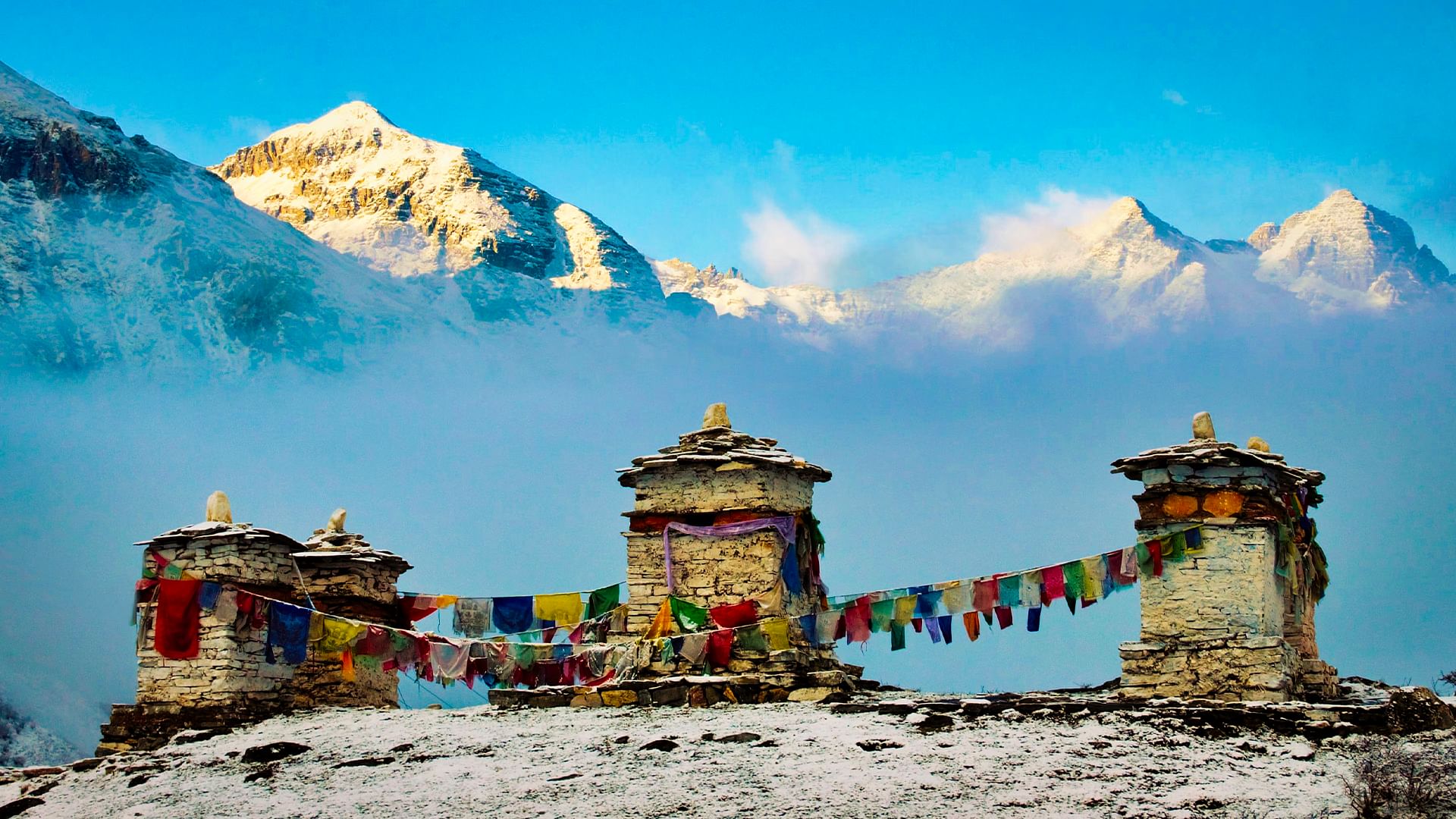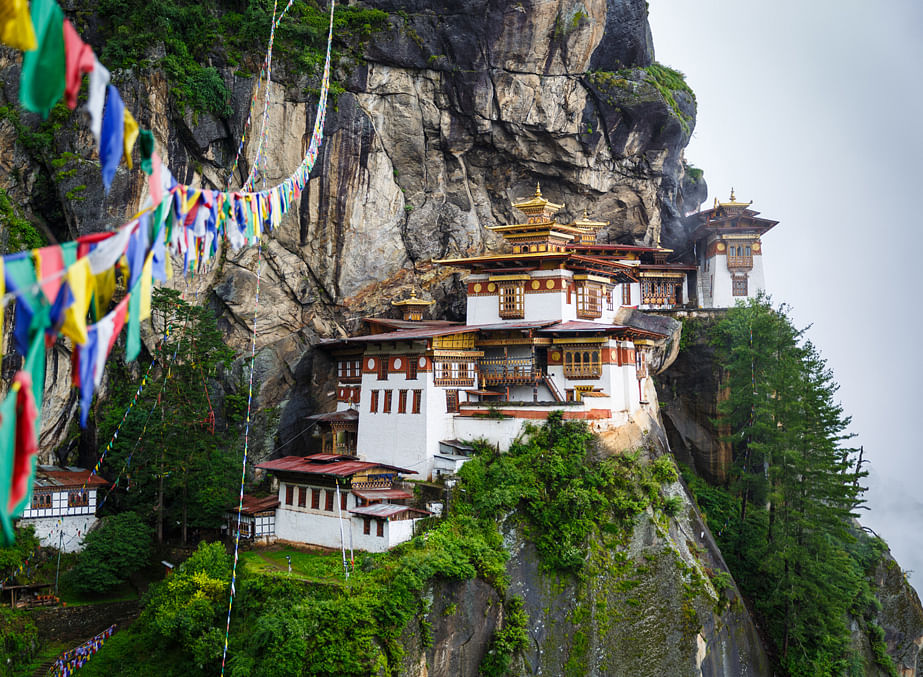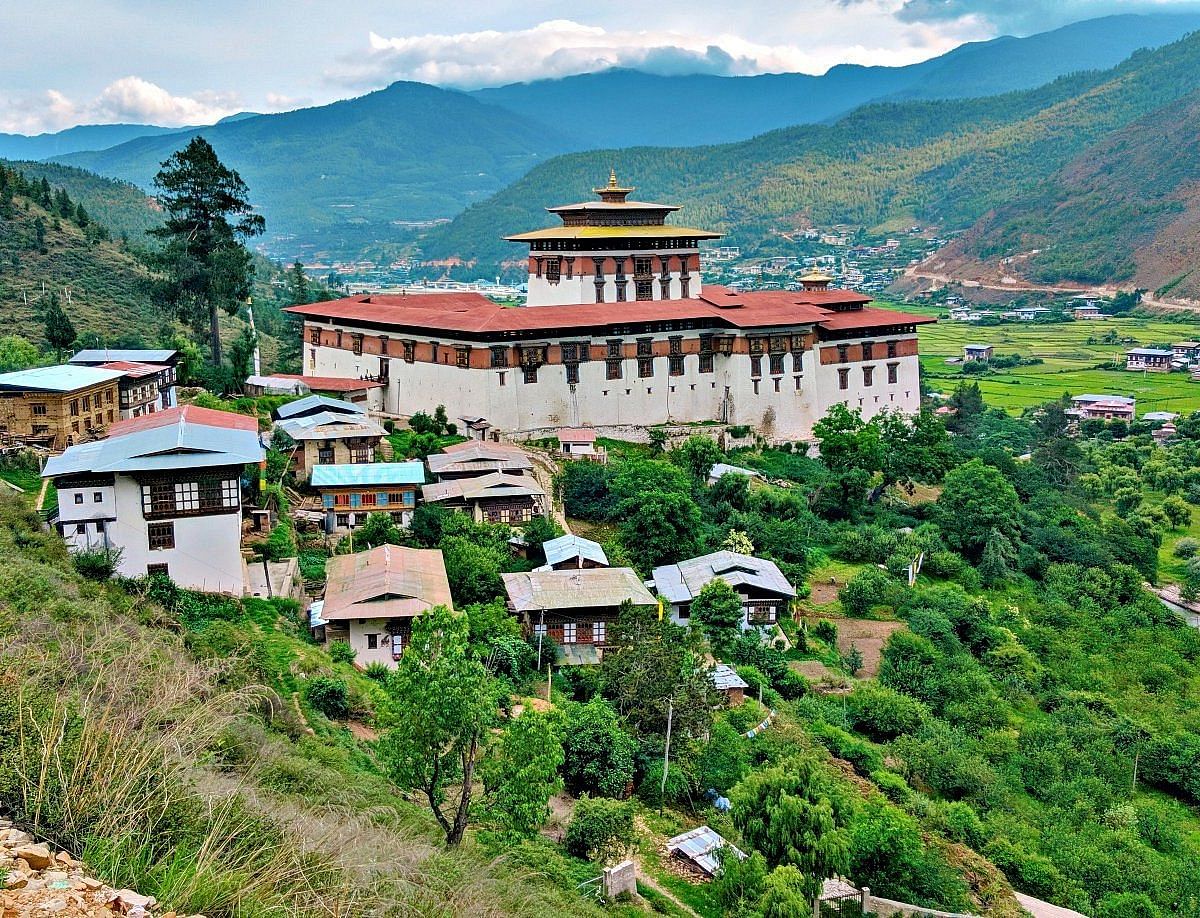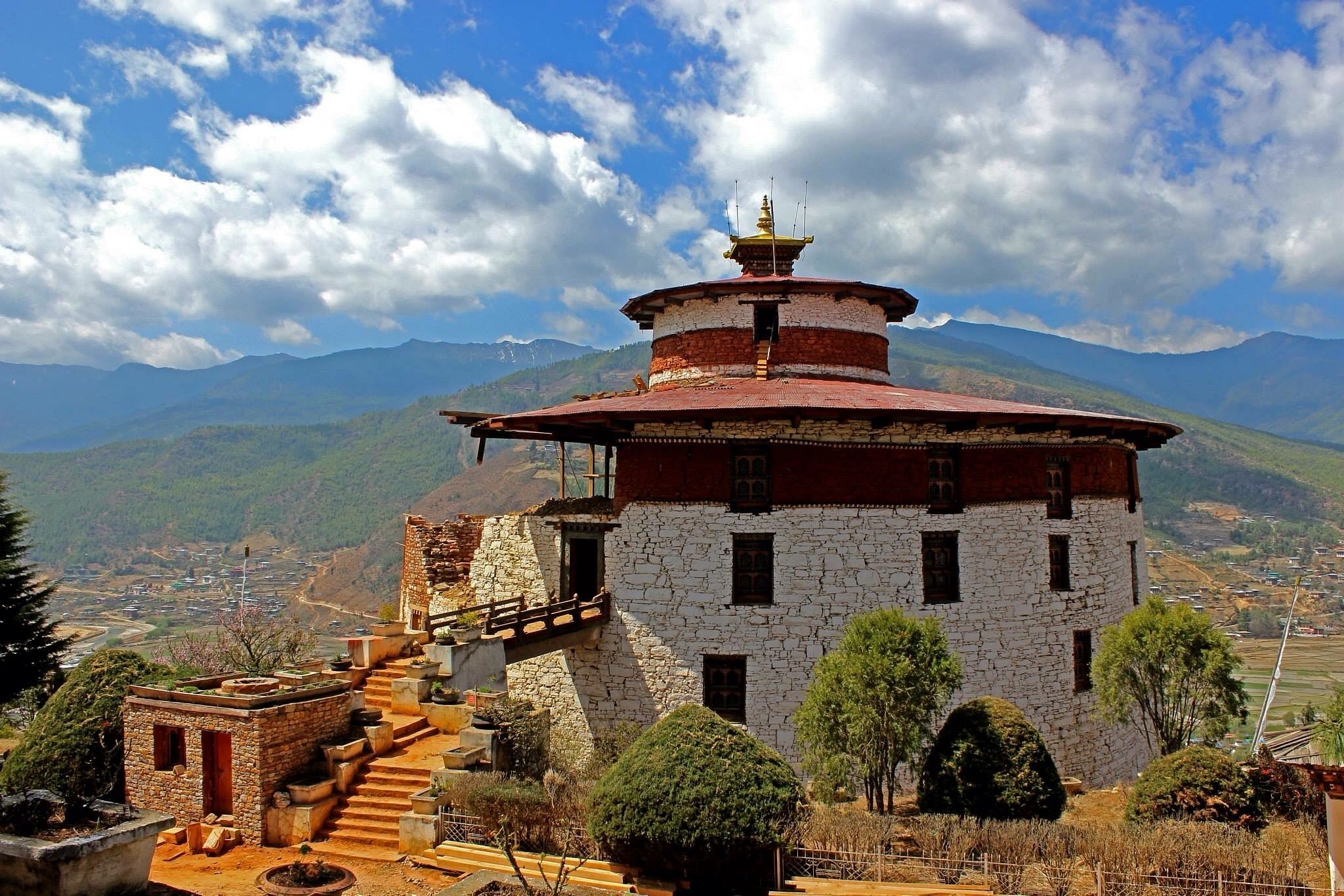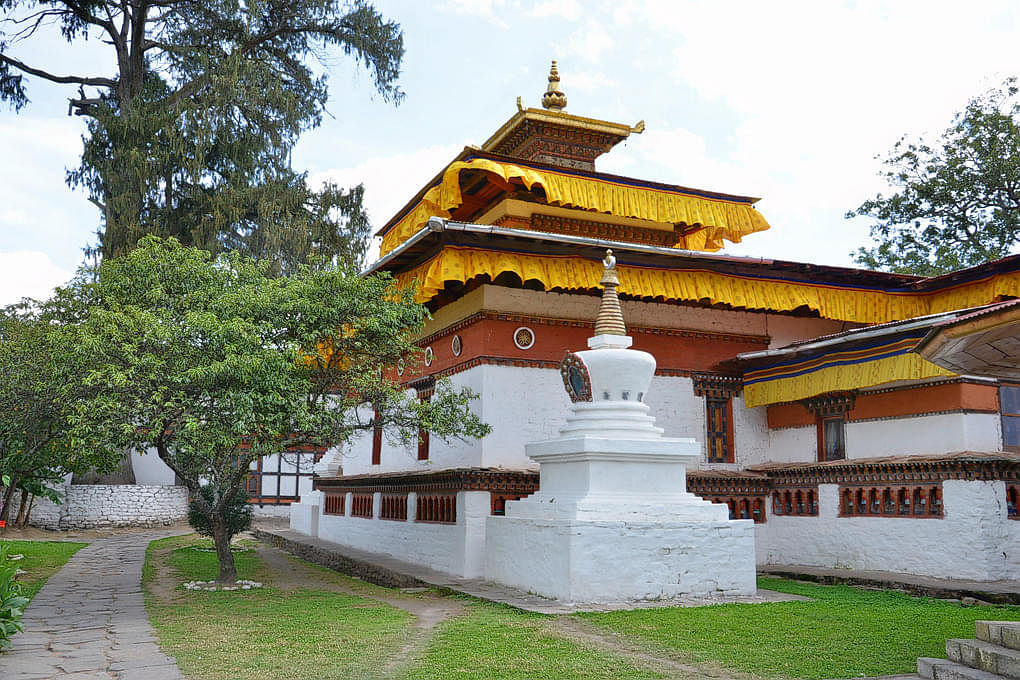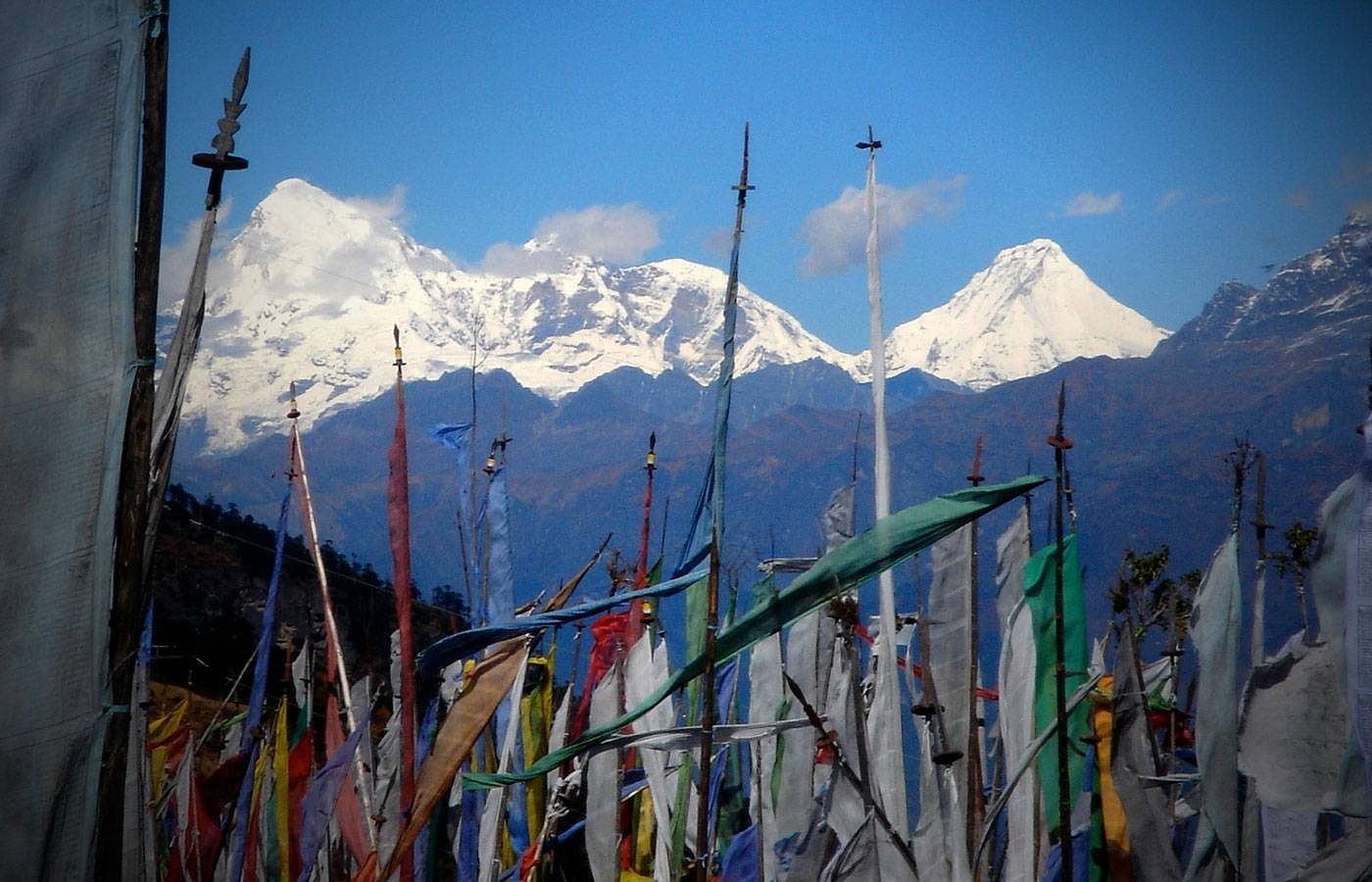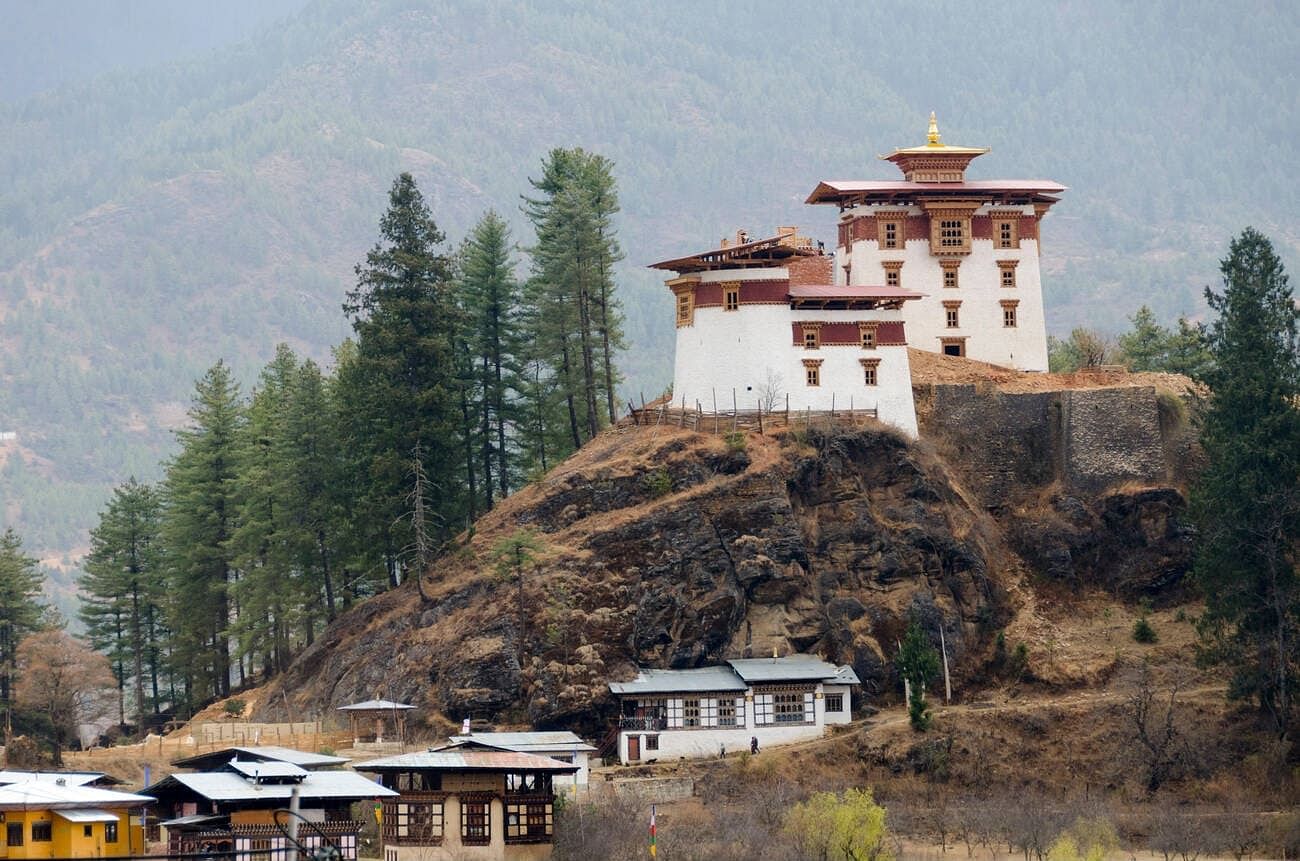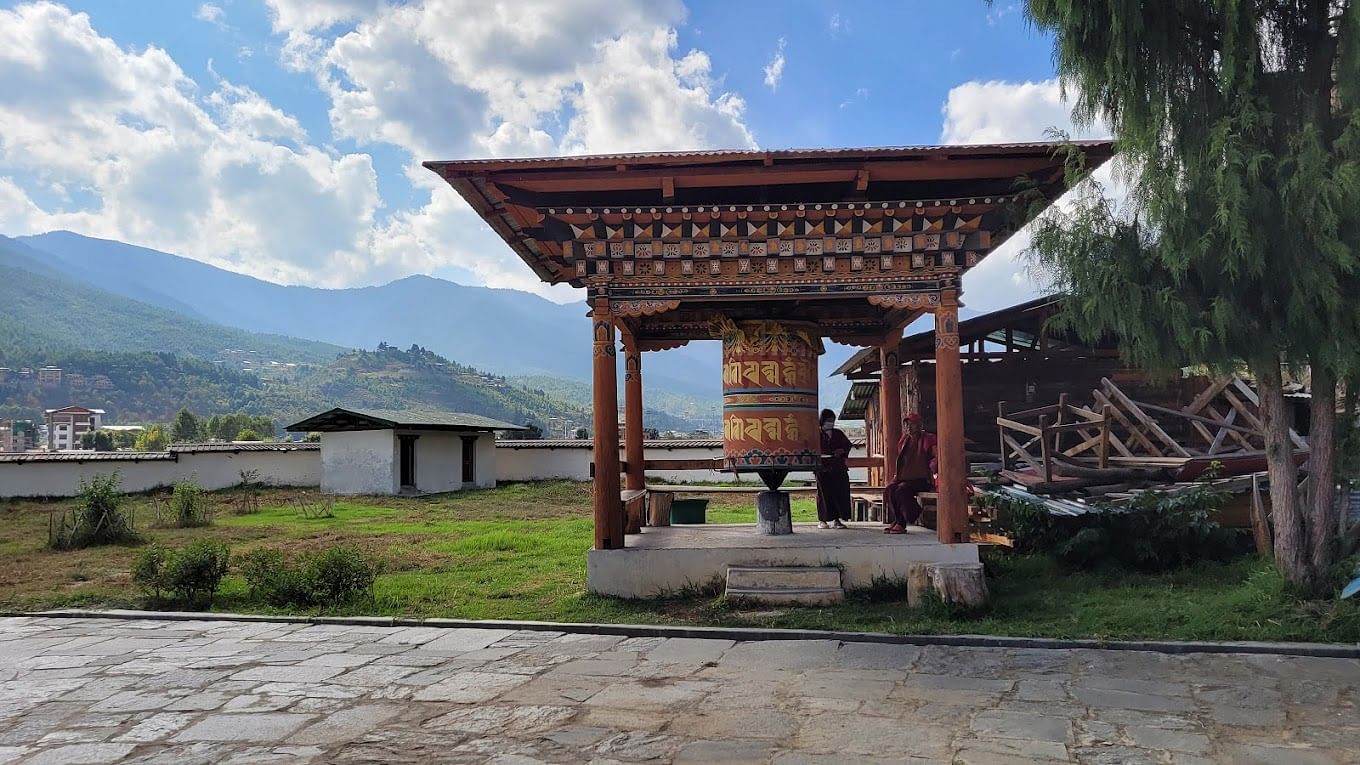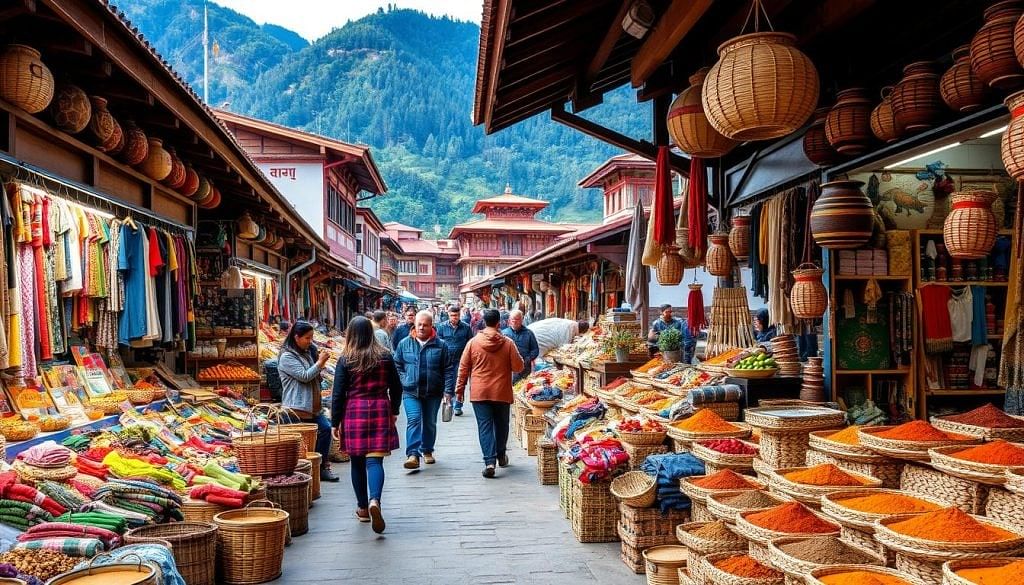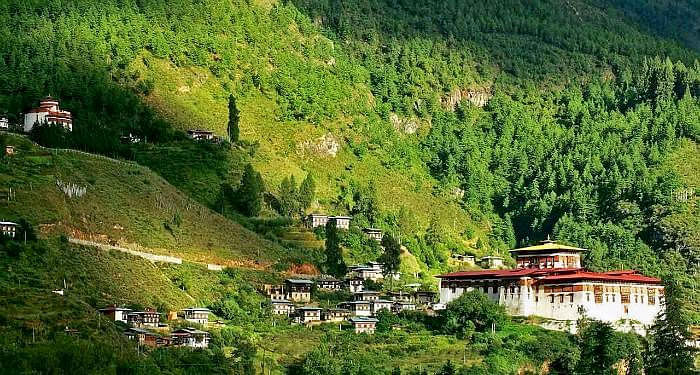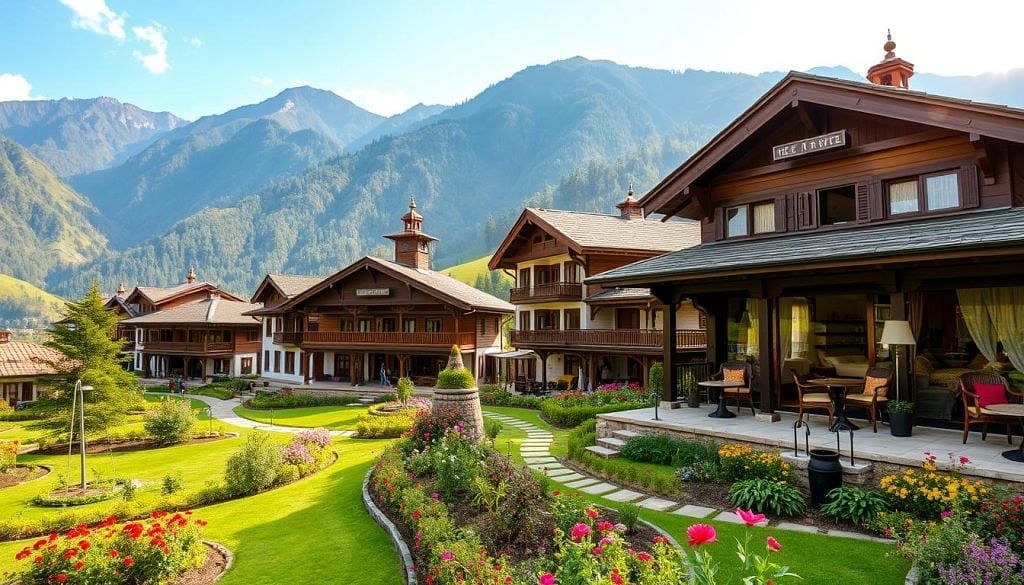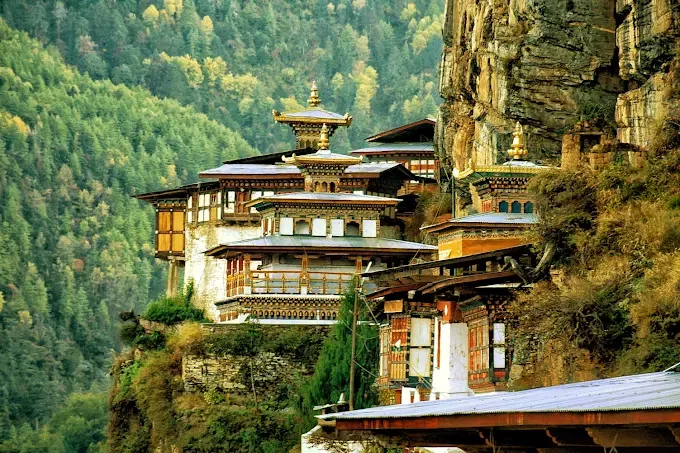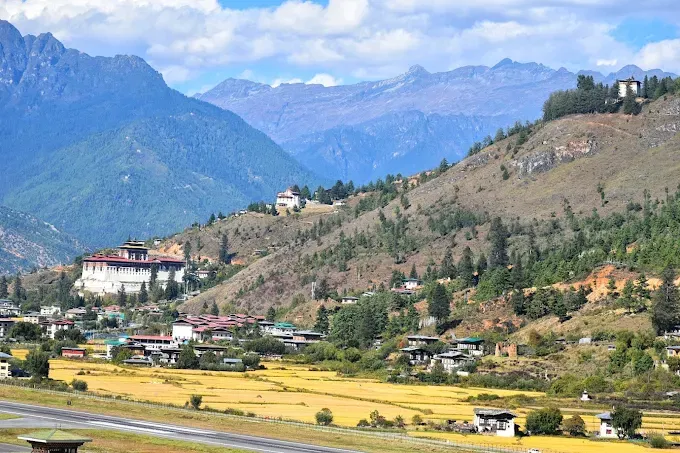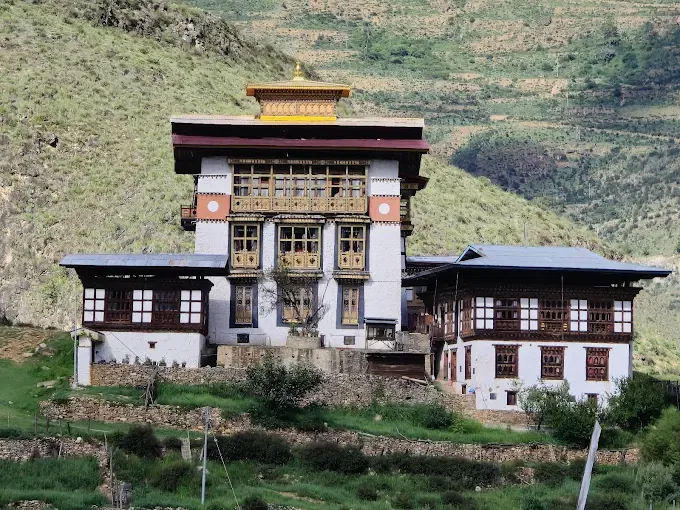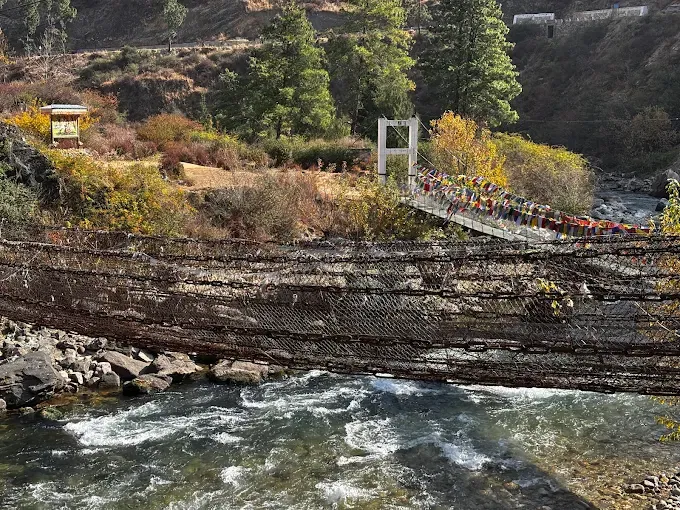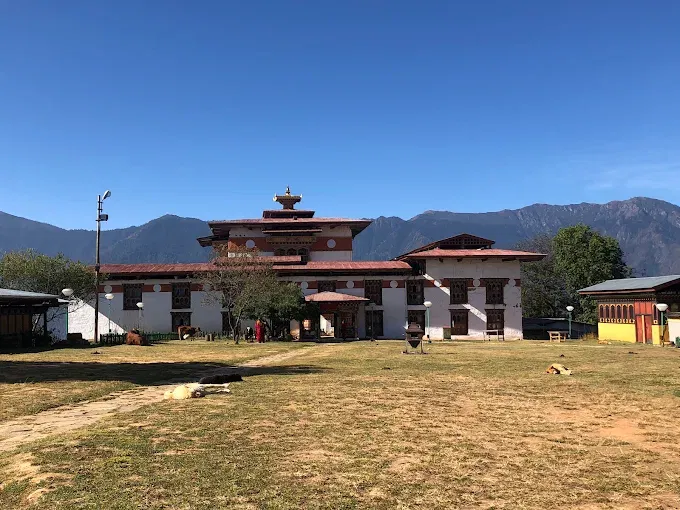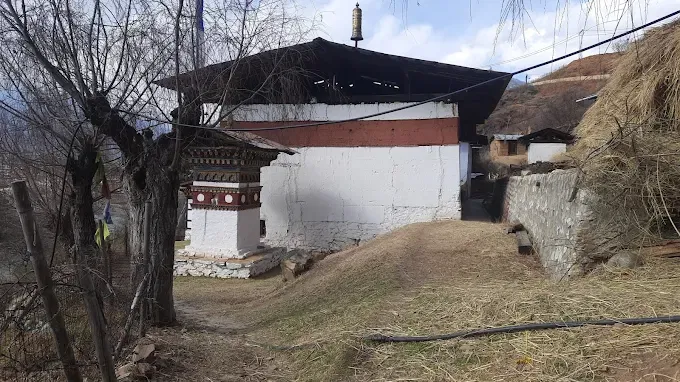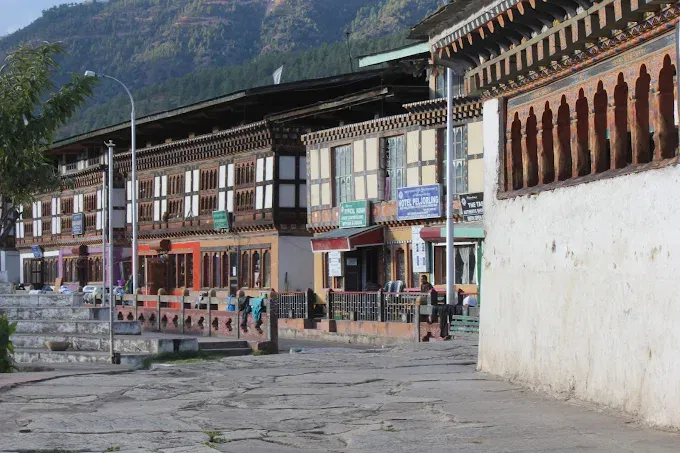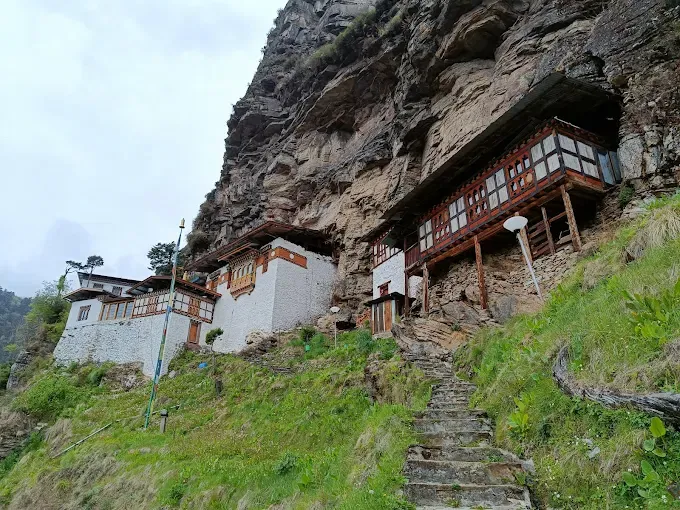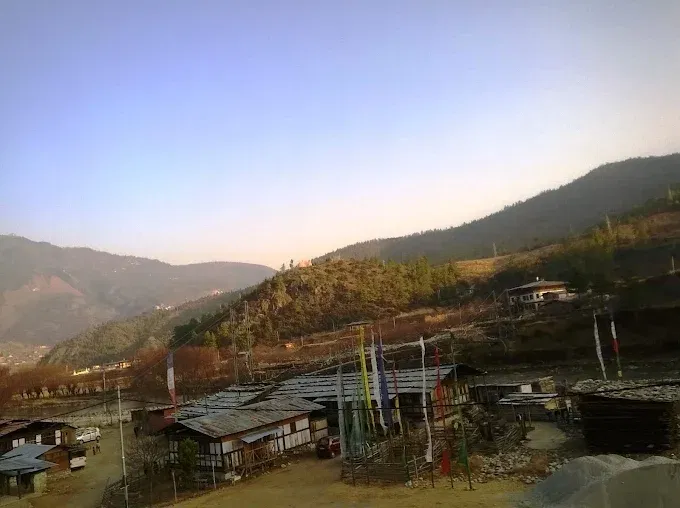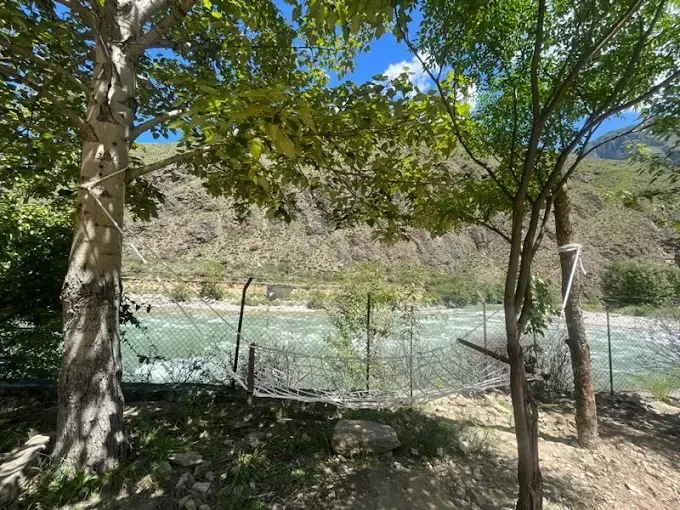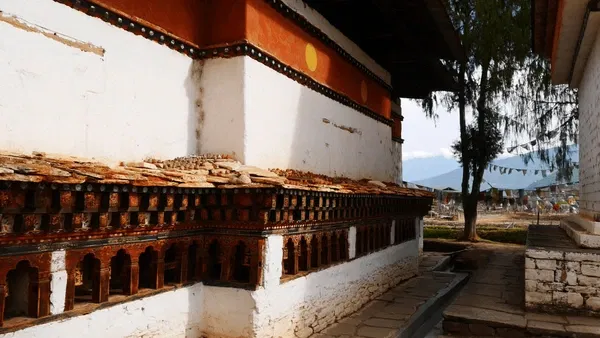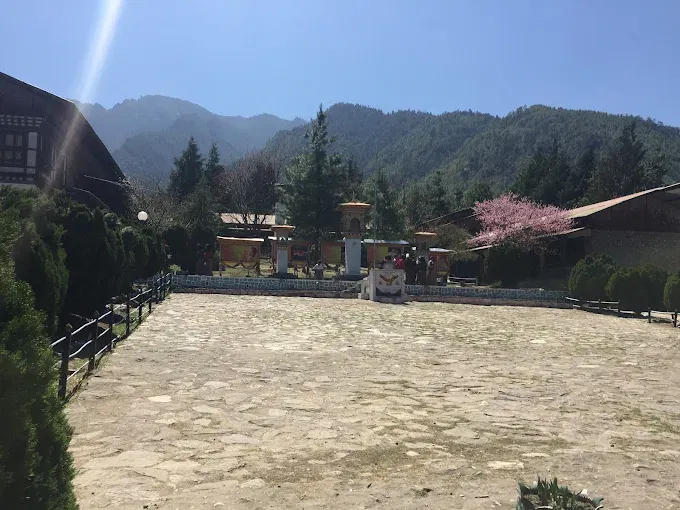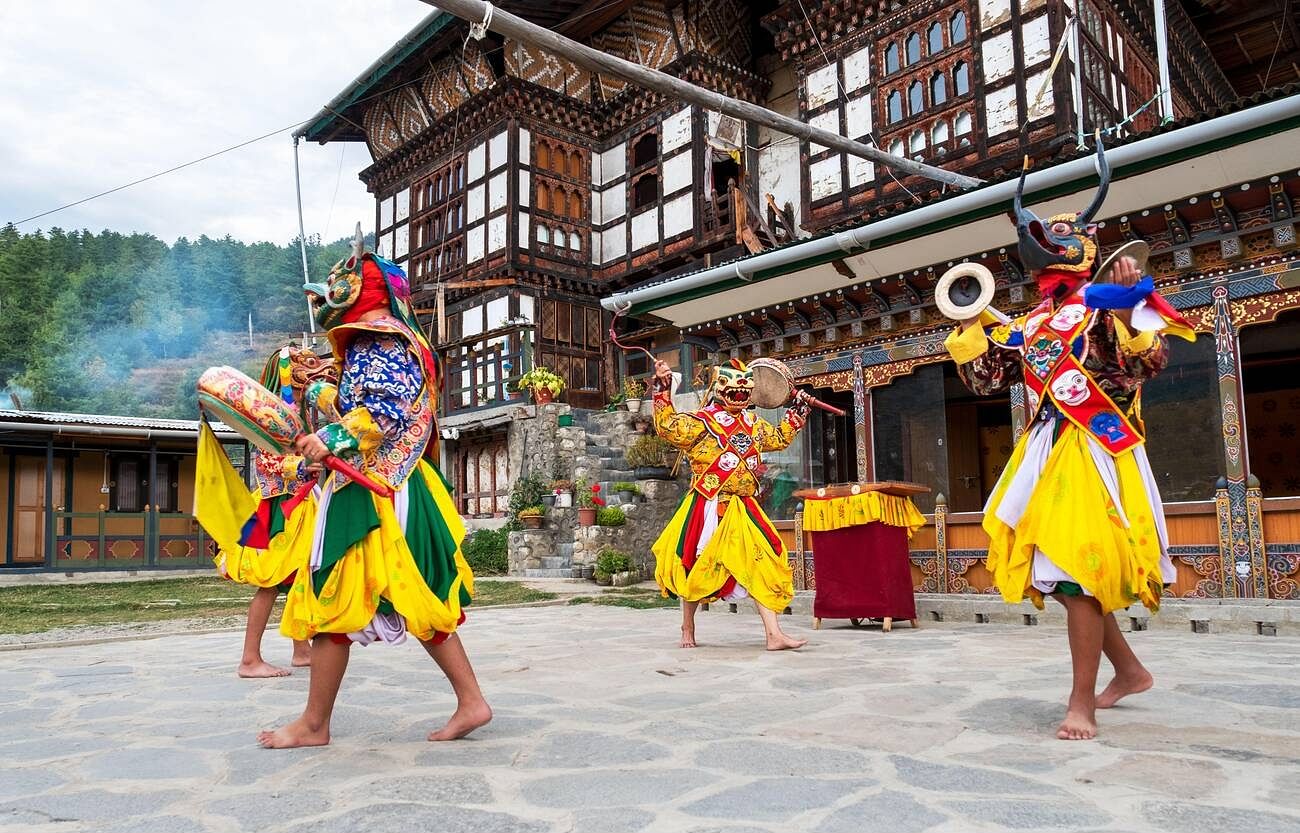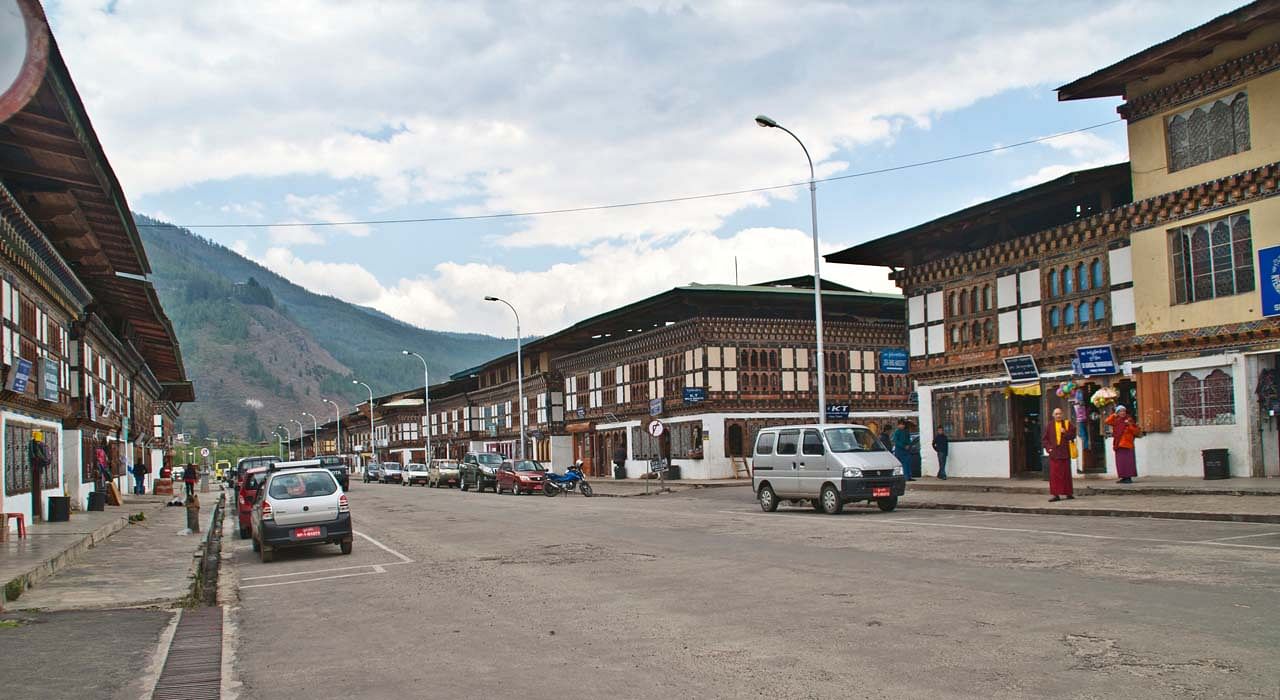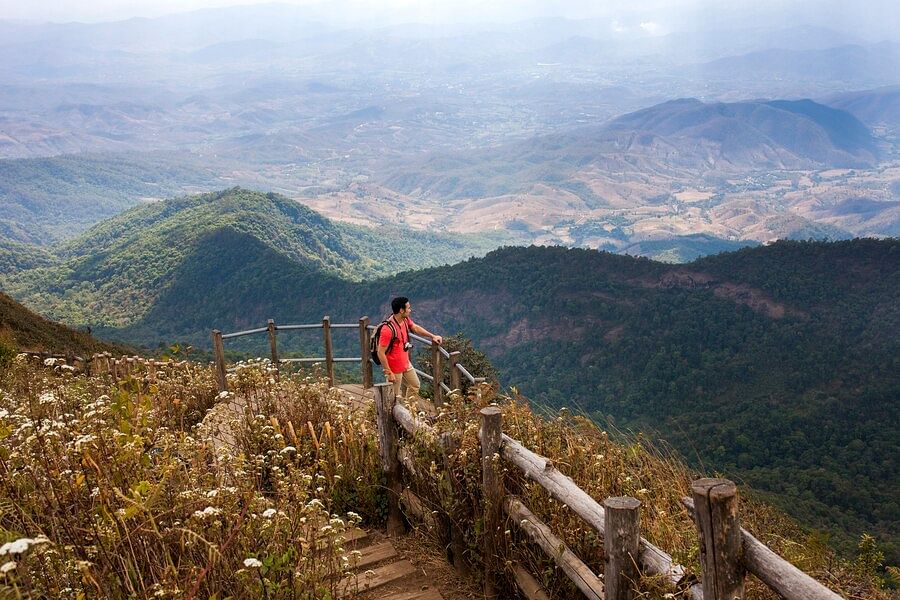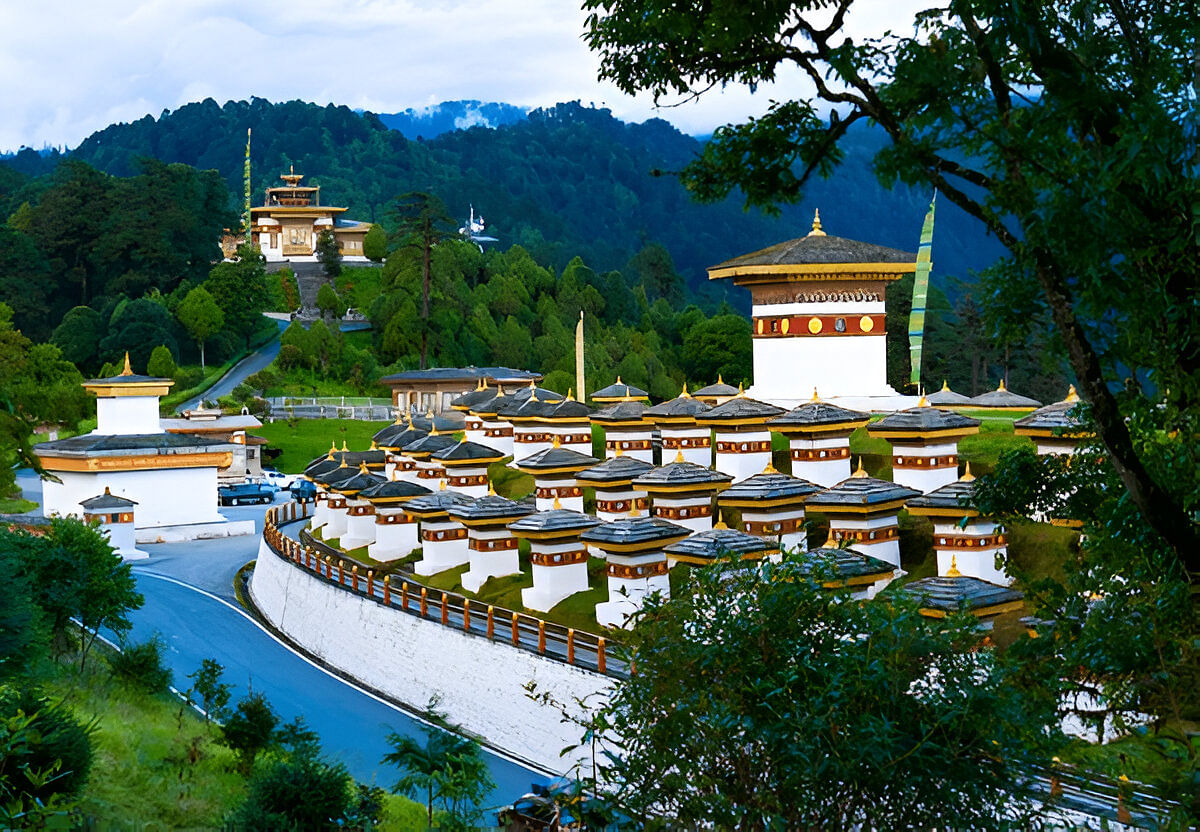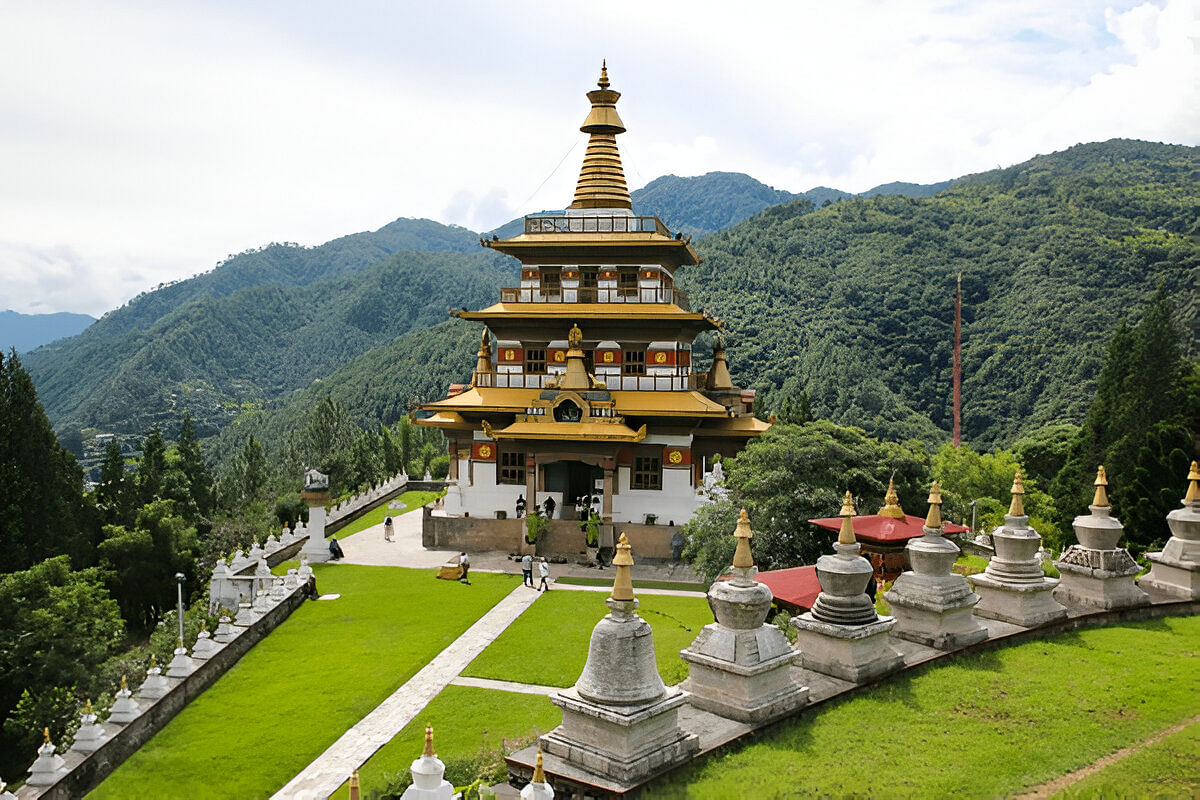Walking through Paro feels like stepping into a storybook! We were amazed by this gem among the places to visit in Bhutan . The Tiger's Nest Monastery will make you stop and stare – it sits on a cliff edge that looks too steep to climb, but trust us, the hike up is worth it for views you'll never forget.
At Paro Dzong, we watched monks in bright red robes saying prayers inside huge fortress walls – it gave us chills! The weekend market is full of life! Sellers call out to shoppers, sweet-smelling incense fills the air, and the handmade crafts are so pretty we had to buy some.
Our best find was the old Kyichu Lhakhang temple at sunset. Old folks walked around it, slowly turning prayer wheels, looking happy in the warm golden light. These special moments make places to visit in Paro truly special. Take a look at our Bhutan Tour Packages to see all these wonderful sights without missing anything!
Ultimate Guide to 24 Places to Visit in Paro, Bhutan
1. Tiger’s Nest Monastery (Taktsang Monastery)
One of the most iconic places to visit in Paro, Tiger’s Nest Monastery sits on a cliffside about 3,000 meters above sea level. This beautiful monastery looks like it’s hanging in the air, surrounded by clouds and pine trees.
According to local legends, Guru Rinpoche flew to this place on a tiger’s back and meditated here. That’s how the monastery got its name – Tiger’s Nest. It is one of the must visit places in Paro and a symbol of Bhutan’s spiritual strength.
The hike to the monastery takes about 2 to 3 hours. It can be a little tough, but the view and the peaceful feeling at the top make it worth the effort. If you're visiting Bhutan, this should be at the top of your list of tourist attractions in Paro.
- Things to Do: Embark on a hike through pine forests, explore the monastery's temples, and enjoy views of the Paro Valley.
- Timings: 8:00 AM – 1:00 PM and 2:00 PM – 6:00 PM
- Location: Approximately 10 km north of Paro town.
- Entry Fee: Included in the Bhutan daily tourist tariff; for Indian nationals, the fee is INR. 488
- How to Reach: A 30–45-minute drive from Paro town to the base, followed by a 2–3-hour uphill hike.
- Best Time to Visit: Spring (March–May) and Autumn (September–November) offer clear skies and pleasant weather, ideal for hiking
Suggested read: Bhutan in December
Another important places to visit in Paro is Paro Rinpung Dzong. This large fortress is built in the traditional Bhutanese style and stands above the Paro River.
The dzong is used as a government office and a monastery. Its wooden bridges, tall walls, and peaceful courtyards give you a deep sense of Bhutanese history. Inside, you will find lovely murals that tell stories from Buddhism.
This is also where the famous Paro Tsechu festival is held every year. During the festival, monks perform mask dances and other rituals. This is a great chance for visitors to see Bhutanese traditions up close.
- Things to Do: Explore the intricate woodwork and murals, attend the annual Paro Tsechu festival, and enjoy views of the Paro River.
- Timings: 8:00 AM – 6:00 PM (March–October); 8:00 AM – 4:40 PM (November–February)
- Location: Central Paro, overlooking the Paro River.
- Entry Fee: Free for Bhutanese and Indian nationals; INR. 488 for other foreign nationals
- How to Reach: Easily accessible by foot or a short drive from Paro town.
- Best Time to Visit: March to May and September to November, coinciding with the Paro Tsechu festival for a vibrant cultural experience
3. National Museum of Bhutan (Ta Dzong)
Right above the Paro Dzong, you’ll find Ta Dzong, a circular watchtower that has been turned into the National Museum of Bhutan. It is one of the most informative places to visit in Paro if you are curious about Bhutanese art, culture, and history.
The museum has a wide range of items such as old weapons, costumes, paintings, and religious relics. The building itself is unique and offers amazing views of the Paro Valley.
This museum is a perfect stop before or after visiting the dzong below. It helps you understand the history and traditions of Bhutan simply and beautifully.
- Things to Do: View exhibits of traditional thangka paintings, ancient artifacts, and natural history displays.
- Timings: Tuesday–Saturday: 9:00 AM – 4:30 PM; closed on national holidays
- Location: Above Paro Rinpung Dzong, offering panoramic views of the valley.
- Entry Fee: Nu. 200 for adults; Nu. 50 for SAARC nationals; Nu. 10 for locals; free for monks, nuns, and children under 10
- How to Reach: A short uphill walk from Rinpung Dzong.
- Best Time to Visit: Spring and autumn for clear views and comfortable weather.
Kyichu Lhakhang is one of the oldest temples in Bhutan. Built in the 7th century, it is a sacred site that continues to be a major spiritual center. It is a calm and peaceful place where many locals come to pray.
If you are looking for the best places to visit in Paro Bhutan, Kyichu Lhakhang is a wonderful choice. The atmosphere is peaceful, and the beauty of the temple lies in its simplicity and spiritual energy.
This temple is also a good spot to learn more about Bhutan’s early history and the introduction of Buddhism to the country.
- Things to Do: Offer prayers, spin the prayer wheels, and admire the ancient architecture.
- Timings: 8:00 AM – 6:00 PM
- Location: Approximately 5 km north of Paro town.
- Entry Fee: INR 990
- How to Reach: A 15-minute drive from Paro town.
- Best Time to Visit: March to May and September to November for pleasant weather and fewer crowds.
Suggested read: Kayaking in Bhutan
Chele La Pass is the highest motorable point in Bhutan, located about an hour’s drive from Paro. At an altitude of 3,988 meters, it offers stunning views of the surrounding mountains, including Mount Jomolhari on a clear day.
If you love nature and beautiful drives, this is one of the top places to visit in Paro. The pass is also decorated with colorful prayer flags fluttering in the wind. It’s a perfect place to take pictures and enjoy the fresh mountain air.
This is a great spot for a day trip and gives you a chance to enjoy the high Himalayan landscapes without a long hike.
- Things to Do: Enjoy views, take photographs, and see the fluttering prayer flags.
- Timings: Accessible throughout the day; best visited during daylight hours.
- Location: Approximately 35 km from Paro town.
- Entry Fee: None.
- How to Reach: A 1.5-hour drive from Paro through winding mountain roads.
- Best Time to Visit: Spring and autumn for clear skies and optimal visibility.
Drukgyel Dzong has great historical value. It was built in the 17th century to celebrate a victory over Tibetan invaders. Today, the remains of the dzong still stand proudly, offering insight into Bhutan’s past.
Although the structure is mostly in ruins due to a fire, it still draws attention for its unique design and strong history. On clear days, you can also catch a glimpse of Mount Jomolhari in the distance.
This is one of the places to visit in Paro if you’re interested in history and quiet, uncrowded spots.
- Things to Do: Explore ruins, enjoy valley views, and photograph Mount Jomolhari on clear days.
- Timings: Daylight hours
- Location: 14 km from Paro town
- Entry Fee: Free
- How to Reach: 30-minute drive from Paro
- Best Time to Visit: March–May, September–November
Dungtse Lhakhang is a unique temple located near Paro town. What makes it special is its unusual shape – it’s built like a chorten (stupa), unlike most other temples.
Inside, the temple has beautiful paintings that show different levels of Buddhist teachings. The temple is small but filled with meaning and history.
It is one of the lesser-known Paro tourist attractions, which makes it perfect for travelers who prefer peaceful and offbeat places.
- Things to Do: Explore the three floors representing hell, earth, and heaven; admire the intricate murals and sculptures.
- Timings: 8:00 AM – 5:00 PM
- Location: Near the new bridge, Paro town.
- Entry Fee: Nu. 300
- How to Reach: A short walk or drive from Paro town center.
- Best Time to Visit: Spring (March–May) and Autumn (September–November) for pleasant weather.
While Paro is known for its temples and dzongs, don’t forget to explore Paro town itself. The streets are lined with traditional Bhutanese houses, small cafes, souvenir shops, and local markets.
You can walk around, try some local food, and buy handmade goods like textiles and handicrafts. If you’re looking for relaxing places to visit in Paro, spending a few hours in the town is a good idea.
This is also a nice place to connect with locals and see everyday life in Bhutan.
- Things to Do: Shop for handicrafts, textiles, and souvenirs; savor Bhutanese cuisine at local restaurants.
- Timings: Shops typically open from 9:00 AM – 7:00 PM
- Location: Central Paro.
- Entry Fee: None.
- How to Reach: Easily accessible by foot or vehicle within Paro.
- Best Time to Visit: Year-round; evenings are particularly lively
Suggested Read: Cafes in Bhutan
For those who enjoy short hikes and beautiful views, the trail to Zuri Dzong is perfect. It’s one of the oldest dzongs in Bhutan and is located on a hill overlooking the Paro Valley.
The hike takes about 1 to 2 hours and passes through pine forests and open fields. Once you reach the top, you’ll be rewarded with peaceful views and fresh air.
If you are searching for must visit places in Paro for outdoor lovers, this hike is ideal. It’s not too hard and can be done by people of most ages.
- Things to Do: Hike through pine forests; explore the ancient fortress; enjoy bird's-eye views of Paro.
- Timings: Daylight hours; advisable to start early morning.
- Location: Trail begins near the National Museum, Paro.
- Entry Fee: None.
- How to Reach: Short drive to the trailhead near the National Museum; hike duration is approximately 1–2 hours.
- Best Time to Visit: Spring and Autumn for clear skies and comfortable temperatures.
10. Farmstay Experiences in Paro Valley
Paro is also known for its beautiful farmlands and traditional village life. Many families open their homes to visitors for farmstay experiences. This is one of the most authentic places to visit in Paro if you want to truly understand the Bhutanese way of life.
You can stay with a local family, enjoy home-cooked meals, help in the fields, and learn about Bhutanese customs. It’s a simple but deeply rewarding experience.
- Things to Do: Participate in farming activities; learn Bhutanese cooking; engage in cultural exchanges.
- Timings: Overnight stays; duration varies based on preference.
- Location: Various villages throughout Paro Valley.
- Entry Fee: Varies; typically ranges from INR. 1,488 – 2988 per night, including meals.
- How to Reach: Arranged through local tour operators; transportation provided as part of the package.
- Best Time to Visit: Spring and Autumn for agricultural activities and festivals.
11. Dzongdrakha Goemba (Mini Tiger’s Nest)
Dzongdrakha Goemba is often called the “Mini Tiger’s Nest” because it also sits on a cliff, but is much easier to reach. It is one of the peaceful places to visit in Paro Bhutan, especially for people who want beautiful views without a long hike. The temple is surrounded by nature, making it perfect for Paro sightseeing. It is also a great stop for families and beginners who want a calm spiritual experience.
- Things to Do: Walk the short trail, explore cliffside temples, and enjoy quiet valley views.
- Timings: 8:00 AM – 5:00 PM
- Location: Near Bondey region, 6–7 km from Paro town.
- Entry Fee: Covered in Bhutan tourism tariff; Indians may pay ₹200–₹300.
- How to Reach: 20–25 minutes by car + 15-minute easy walk.
- Best Time to Visit: Spring and autumn.
12. Paro Airport Viewpoint / Runway View Point
This viewpoint is one of the most exciting Paro tourist attractions because you can watch planes land at one of the world’s most challenging airports. The view of the valley, houses, and mountains makes it a fun spot for photos. It is one of the places to visit in Paro that is enjoyed by both kids and adults. The landing looks dramatic, so many tourists come here just for this special experience.
- Things to Do: Watch planes land, take photos, and enjoy mountain views.
- Timings: Open all day.
- Location: Opposite Paro Airport runway.
- Entry Fee: Free.
- How to Reach: 5–10 minutes by car from Paro town.
- Best Time to Visit: Morning or late afternoon.
Tachogang Lhakhang is a lovely temple located near the highway, and the iron bridge outside is very famous. It was created by Thangtong Gyalpo, known for making strong chain bridges. This spot is one of the Paro tourist places where you can learn about old Bhutanese engineering. Walking on the bridge feels adventurous but safe. It’s one of the places to visit in Paro if you enjoy history, nature, and scenic landscapes.
- Things to Do: Walk across the iron bridge, visit the temple, and enjoy riverside views.
- Timings: 8:00 AM – 5:00 PM
- Location: Paro–Thimphu Highway, about 15 km from Paro.
- Entry Fee: Usually covered under tariff; Indians may pay ₹100–₹200.
- How to Reach: 20–25 minutes by car from Paro town.
- Best Time to Visit: Year-round.
The Tamchog Iron Bridge is another beautiful example of the ancient chain bridges of Bhutan. It is one of the top attractions in Paro for visitors who want to experience something unique. Surrounded by green hills and a peaceful river, this place gives a nice village feel. It is one of the places to visit in Paro for people who love photography and want to explore traditional Bhutanese craftsmanship.
- Things to Do: Cross the bridge, take pictures, and enjoy the scenic river.
- Timings: Open during daylight hours.
- Location: Near Tachogang, on the main highway.
- Entry Fee: Free to view; a small fee may apply to cross.
- How to Reach: 20 minutes by car.
- Best Time to Visit: March–November.
15. Sangchen Choekhor Monastery
Sangchen Choekhor is a quiet hilltop monastery with stunning views of the Paro Valley. It is one of the Best Places to visit in Paro if you enjoy peaceful surroundings. The monastery is also a learning centre for monks, so you can see young monks studying and praying. The drive up the mountain is beautiful, making it one of the best places to visit in Paro Bhutan for nature lovers and spiritual travellers.
- Things to Do: Explore the monastery, talk to monks, and enjoy panoramic valley views.
- Timings: 8:00 AM – 6:00 PM
- Location: Hilltop above Paro, around 12 km from town.
- Entry Fee: Included in tourism tariff; Indians may pay ₹100–₹200.
- How to Reach: 30–40 minutes uphill drive.
- Best Time to Visit: Clear-weather months (Oct–May).
Jangsarbu Lhakhang is a small temple located near Paro Rinpung Dzong. It contains a special statue of Tara, who is believed to protect people from harm. This temple is one of the quieter places to visit in Paro, making it great for travellers who want peaceful moments. It gives a very local feeling, and you can also enjoy a short walk around the area. It is one of the warm Paro tourist attractions.
- Things to Do: See the sacred Tara statue, join prayers, and explore the nearby Paro Dzong surroundings.
- Timings: 8:00 AM – 5:00 PM
- Location: Close to Rinpung Dzong, central Paro.
- Entry Fee: Covered under tariff; Indians may pay ₹50–₹100.
- How to Reach: 5 minutes by car or a short walk.
- Best Time to Visit: Year-round.
17. Paro Choeten Lhakhang
Paro Choeten Lhakhang is a nice place for slow walks and peaceful prayer time. Located inside Paro town, it is one of the convenient places to visit in Paro for people who like exploring nearby spiritual spots. The white chorten and prayer flags create a calm environment. Many locals visit in the morning, so you can see Bhutanese culture up close. It is a simple but meaningful stop during Paro sightseeing.
- Things to Do: Walk around the stupa, pray with locals, and enjoy the quiet town surroundings.
- Timings: Open from morning to evening.
- Location: Inside Paro town.
- Entry Fee: Free.
- How to Reach: Reachable by walking from most hotels.
- Best Time to Visit: Early morning or sunset.
18. Kila Nunnery (Kila Goemba)
Kila Nunnery sits on a cliff near Chele La Pass and is known as Bhutan’s oldest nunnery. It is one of the most peaceful places to visit in Paro because it feels far away from busy life. The views of mountains and forests are stunning. You can often see nuns praying or studying. It is also one of the calm and romantic places to visit in Paro for couples who enjoy nature and quiet places.
- Things to Do: Visit the nunnery, observe prayers, and enjoy mountain views.
- Timings: 8:00 AM – 5:00 PM
- Location: Near Chele La Pass, around 25 km from Paro.
- Entry Fee: Included in tariff; Indians may pay ₹200–₹300.
- How to Reach: 45–60 minutes by car + short walk.
- Best Time to Visit: April–June and Sept–Nov.
Bondey Village is a traditional village near Paro Airport. It is one of the best Family-friendly places to visit in Paro because you can see real Bhutanese homes, farms, and local life. People here are friendly, and the village is surrounded by mountains and fields. It is one of the simple places to visit in Paro if you want to learn about daily Bhutanese culture and enjoy slow travel.
- Things to Do: Explore farms, meet locals, and enjoy countryside views.
- Timings: Open all day.
- Location: Close to Paro Airport.
- Entry Fee: Free.
- How to Reach: 5–8 minutes by car.
- Best Time to Visit: Year-round
20. Shaba Village & Shaba Lhakhang
Shaba Village is known for its calm and pretty countryside views. The village feels slow and peaceful, making it one of the relaxing places to visit in Paro. Shaba Lhakhang, the local temple, adds a spiritual touch to the area. You can enjoy short walks, talk to villagers, and see farming activities. It is one of the must visit places in Paro for travellers who enjoy rural life.
- Things to Do: Visit the temple, take nature walks, and see village life.
- Timings: 8:00 AM – 5:00 PM
- Location: Located a few km south of Paro town.
- Entry Fee: Free or small temple fee (₹50–₹100).
- How to Reach: 10–15 minutes by car.
- Best Time to Visit: Spring and autumn.
21. Isuna Village (Isuna Farm Area)
Isuna Village is a beautiful riverside area along the Paro–Thimphu highway. It is one of the pleasant places to visit in Paro Bhutan if you love nature. Many people stop here for picnics or photos because the river, fields, and mountains make the place look picture-perfect. It’s also peaceful, making it one of the enjoyable places to visit in Paro for families and casual travellers.
- Things to Do: Picnic by the river, click photos, and enjoy the peaceful nature.
- Timings: Open all day.
- Location: Paro–Thimphu Highway.
- Entry Fee: Free.
- How to Reach: 20–25 minutes by car.
- Best Time to Visit: March–October.
Jangta Lhakhang is a small and lesser-known temple that gives a quiet and spiritual feeling. It is one of the hidden places to visit in Paro for travellers who want to avoid crowds. The simple architecture and peaceful surroundings make it a nice stop for anyone exploring rural Bhutan. It is also a good example of traditional Bhutanese temple design and a calm Tourist Attraction in Paro.
- Things to Do: Explore the shrine, enjoy quiet surroundings, and observe local rituals.
- Timings: 8:00 AM – 5:00 PM
- Location: In a rural part of Paro Valley.
- Entry Fee: Usually free or ₹50–₹100.
- How to Reach: 20–30 minutes by car.
- Best Time to Visit: Morning hours
23. Drugyel High School Viewpoint
The viewpoint near Drugyel High School offers amazing views of the hills and valley. It is one of the places to visit in Paro if you enjoy simple but beautiful scenery. The area is quiet and perfect for short walks or sunset photos. Many travellers stop here while visiting nearby spots. It is also listed among the Top Places to Visit in Paro for nature lovers.
- Things to Do: Enjoy valley views, take photos, and walk around the peaceful area.
- Timings: Open during daylight hours.
- Location: Near Drukgyel area, about 14 km from Paro.
- Entry Fee: Free.
- How to Reach: 25–30 minutes by car.
- Best Time to Visit: Sunset.
Lamgong Village is a peaceful rural area with farms, fields, and traditional Bhutanese homes. It is one of the relaxing places to visit in Paro when you want to escape busy town areas. The village is perfect for slow walks and understanding Bhutanese daily life. Because of its natural beauty, it is also one of the must visit places in Paro for culture lovers.
- Things to Do: Walk through farmlands, interact with locals, and see traditional homes.
- Timings: Open all day.
- Location: North of Paro town.
- Entry Fee: Free.
- How to Reach: 10–12 minutes by car.
- Best Time to Visit: October–May.
Best Time to Visit Paro Bhutan
The best time to visit Paro Bhutan, is during spring (March to May) and autumn (September to November). These months offer clear skies, pleasant weather, and colorful festivals like the Paro Tsechu.
Spring is great for flowers and greenery, while autumn provides crisp air and excellent mountain views. If you're interested in cultural events, try to time your visit with the festival dates.
Wondering how to reach Paro? Paro, Bhutan, is accessible via air, road, and a combination of train and road travel. Here's how you can reach Paro from India:
The easiest way is by air. Paro International Airport is the only international airport in Bhutan and is well-connected with cities like Delhi, Kolkata, and Bangkok.
By Air
Paro International Airport is Bhutan's sole international airport, situated approximately 6 km from Paro town. It is served by Druk Air and Bhutan Airlines, offering direct flights from Indian cities such as Kolkata, Delhi, and Mumbai. Flights from Kolkata are frequent and take about 1.5 hours. Due to the airport's challenging terrain, flights are subject to weather conditions, so it's advisable to check schedules in advance.
By Train and Road
Bhutan does not have a railway network. However, travelers can take a train to Indian border towns and then proceed by road:
- To Hasimara Station: From Kolkata, take a train to Hasimara in West Bengal. From there, it's a short drive to Jaigaon, the Indian town bordering Bhutan. Cross into Phuentsholing, Bhutan's border town, and continue by road to Paro (approximately 6–7 hours).
- To New Jalpaiguri (NJP) or Siliguri: These stations are well-connected to major Indian cities. From NJP/Siliguri, drive to Jaigaon and follow the same route through Phuentsholing to Paro.
By Road
Traveling by road offers scenic views of the Himalayan landscape:
- From Kolkata: The Royal Bhutanese Government operates buses from Kolkata's Esplanade Station to Phuentsholing. The journey takes about 18 hours. From Phuentsholing, hire a taxi or take a bus to Paro (approximately 6–7 hours).
- Self-Drive or Taxi: Drive from Kolkata to Jaigaon (approximately 17 hours). After crossing into Phuentsholing, continue to Paro by road.
Entry Requirements for Indian Citizens
Indian nationals do not require a visa to enter Bhutan. However, they must carry a valid passport or Voter ID card. An Entry Permit is issued at the border (Phuentsholing) or upon arrival at Paro airport. For travel beyond Paro and Thimphu, a Special Area Permit is required, obtainable from the Immigration Office in Thimphu.
Suggested Read: Whitewater Rafting in Bhutan
Conclusion
Paro is a place of natural charm, spiritual depth, and cultural beauty. Whether you are a history lover, an adventure seeker, or someone who wants peace, Paro has something for you. From ancient monasteries and fortresses to peaceful hikes and traditional town markets, the valley offers a truly Bhutanese experience.
With this guide to the top places to visit in Paro, you can now plan a trip that mixes sightseeing, adventure, and cultural learning. Don’t forget to enjoy the local hospitality and take in the beautiful mountain views that surround you everywhere in Paro.
So pack your bags and explore the heart of Bhutan through these places to visit in Paro. It’s a journey you’ll always remember!




